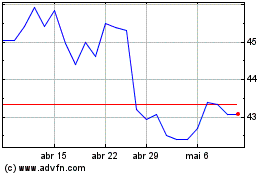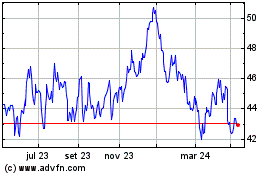By Rhiannon Hoyle
The world's biggest miners, flush with profits from a recent
commodity market rebound, are grappling with a new challenge: how
to keep rising costs from eating into those hard-earned gains.
For much of this decade, mining companies have prioritized
reducing how much they spend to dig up each ton of the commodities
they sell, after a market slump made it harder to turn a profit.
Companies including BHP Billiton Ltd., Rio Tinto PLC and Glencore
PLC introduced drones and driverless trucks, cut tens of thousands
of jobs and sought advice from other industries including
automobiles to make their pits more efficient.
Now the sector faces a fresh cost crunch as prices for things
including fuel, wages and chemicals begin to climb. Energy bills
are rising following a more than 20% rally in oil this past year.
Raw materials including coke, which helps to fuel iron-ore
smelters, and caustic soda, used to extract alumina from bauxite,
are also rocketing in price. Workers are demanding higher wages in
many countries, including the copper mining hub of Chile, where
truck drivers argue better metal prices should translate to fatter
pay packets.
A depreciating U.S. dollar versus the currencies of top mining
countries is also putting pressure on margins, as commodities are
mostly sold using the greenback. The South African rand is up 22%
over the past four months.
"Clearly, inflation's becoming a bigger issue," said Anglo
American PLC Chief Executive Mark Cutifani. "So we've got to run
twice as hard." Costs are increasing for reasons similar to those
driving the commodity market turnaround: a healthier global economy
and rising demand.
Miners stripped billions of dollars in costs from their
operations as they sought to get a handle on budgets that spiraled
during the last commodities boom.
Between 2012 and 2016, copper producers globally slashed their
output costs -- the cost to produce one pound of metal -- by
roughly one quarter, according to data from S&P Global Market
Intelligence. Still, that followed a more-than-tripling of costs in
the decade prior to 2012. S&P projects copper output costs rose
in 2017 for the first time in five years.
Right now, higher commodity prices are certainly more than
offsetting higher expenses. Commodity prices have climbed roughly
20% since mid-2017, according to the S&P GSCI commodities
index, underpinned by a rare period of synchronized economic growth
in China, the U.S., Europe and major economies elsewhere.
Miners are making huge profits once again. Rio Tinto, the
world's No. 2 miner by market value, and rival Anglo American both
last month reported a doubling of annual net profit. Glencore said
it quadrupled its earnings in 2017.
With fuel and other necessary raw materials getting more
expensive, there will be pressure to find fresh cuts elsewhere to
protect margins, executives say. A further rise in mining costs
could provide an additional boost to the commodity market rally,
analysts say, particularly if investors bet on it causing some
smaller companies to pare production.
"The one thing that comes with inflation is a better commodity
price," said Anglo's Mr. Cutifani. But "we don't want to rely on
rising prices," he said.
Mr. Cutifani said Anglo will race inflation to cut the costs it
can, targeting an extra US$3 billion to US$4 billion in savings by
2022 through improvements to expenses, productivity and sales.
The return of inflationary pressures already sparked earnings
misses for several industry titans during the latest corporate
earnings season, dampening their stock-market rally. "Further cost
inflation in the mining industry is inevitable, in our view, unless
global economic activity slows," said Jefferies LLC analyst
Christopher LaFemina. BHP and Rio, among others, fell short of his
earnings forecasts because of unexpectedly high costs, he said.
Anglo American felt the sharpest sting in its South African coal
division, where costs for its export operations jumped 29%.
Rio Tinto forecast cost headwinds of US$300 million in 2018,
which would erase half its projected productivity improvements for
this year. "We will continue to be tough on costs," pledged Rio CFO
Chris Lynch.
Glencore Chief Financial Officer Steve Kalmin said the company
was seeing rising prices in diesel, steel and explosives, among
other things. There is also increasing competition for workers,
although it is "nowhere near where things were back in the 2007-08"
period when there was a scramble for basic skills, he said.
BHP Billiton cautioned of pockets of inflation in both its
petroleum and minerals businesses, although Chief Executive Andrew
Mackenzie played down concerns that renewed pressures would dent
the miner's bottom line.
"We, as a company, feel confident that we are able to quench
that and continue to drive our cost down," he said.
Write to Rhiannon Hoyle at rhiannon.hoyle@wsj.com
(END) Dow Jones Newswires
March 12, 2018 06:44 ET (10:44 GMT)
Copyright (c) 2018 Dow Jones & Company, Inc.
BHP (ASX:BHP)
Gráfico Histórico do Ativo
De Mar 2024 até Abr 2024

BHP (ASX:BHP)
Gráfico Histórico do Ativo
De Abr 2023 até Abr 2024
